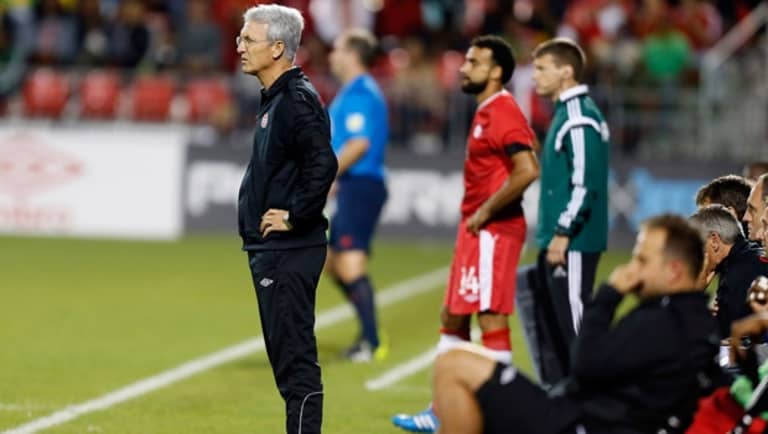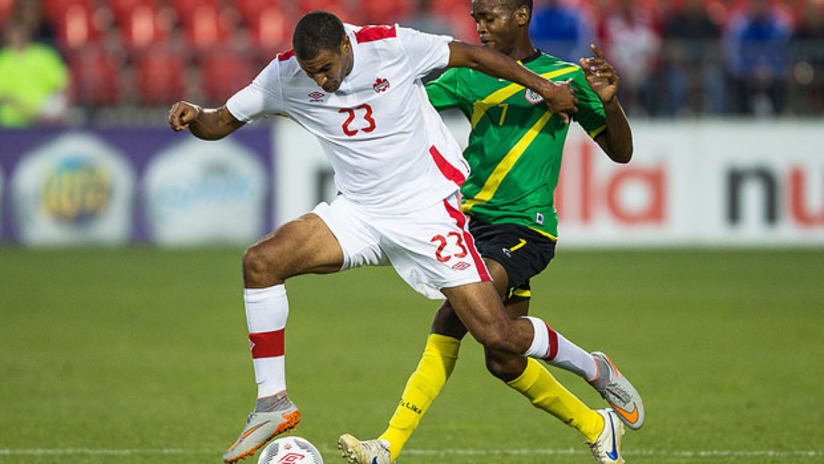To borrow a line from the U.S. women’s national team: now it gets real.
After two years of tinkering and building, head coach Benito Floro will finally get the chance to lead his Canadian team into some serious, competitive matches (sorry, Dominica) at next month’s CONCACAF Gold Cup. As of Tuesday afternoon, we know the 23 men who’ll be leading that charge.
Floro has said that his (quite lofty) goal is reaching the tournament final, something Canada’s only done once. That came back in 2000, when we won the thing.
Up until a week ago, I was saying that – based on the groups and the format for the knockout stage – a spot in the semifinals wasn’t an unrealistic expectation. But now? Well, it’s safe to say the Canadian team have their work cut out for them, and all thoughts of that title-winning team should be put on hold.
While the composition of the roster was relatively easy to predict (I went 18 for 23, if anyone’s counting), there are a few jarring omissions. The Canadian team will be missing its No. 1 midfielder – some would say No. 1 player, period – in Atiba Hutchinson who, as reported by Sportsnet’s John Molinaro, is battling a nagging groin injury.

Will Johnson
(pictured at right), who’s rounding back into form with Portland after recovering from a broken leg, also won’t be on the roster. Floro hinted at this following Canada’s recent World Cup qualifiers against Dominica, suggesting Johnson wasn’t yet physically ready for the sort of aggressive pressing the manager wants his players to perform.
Most surprising, though, is the omission of No. 1 goalkeeper Milan Borjan, last seen being sent off down in Rouseau, Dominica. Borjan, who was on Canada’s provisional 35-man Gold Cup roster, recently re-signed with Bulgarian club Ludogorets Razgrad, who will be playing in UEFA Champions League qualifiers in July.
Borjan’s decision not to join up with the Canadian squad means that the goalkeeping load at the Gold Cup will be carried by some combination of veterans Lars Hirschfeld and Kenny Stamatopoulos, neither of whom have played with any regularity in the last two years. Twenty-year-old Quillan Roberts, who has yet to actually debut for Toronto FC’s first team, will be carrying the water as the third-string 'keeper.
While the absence of Hutchinson, Johnson and Borjan doesn’t fundamentally alter Canada’s chances in its tough Gold Cup group – which also includes El Salvador, Jamaica and Costa Rica – it does probably downgrade the forecast for those first two games from “probably winnable” to “possibly winnable.”
The fact that we’re discussing (well, I’m discussing, but you’re hopefully nodding along in quasi-agreement) Canada’s chances of winning two of its group-stage games is a testament to the turnaround the team has seen under Floro. Let’s not forget that at the 2013 Gold Cup, the Canadian team, with the program still in tatters following a traumatic exit from 2014 World Cup qualifying, went without a win or a goal, and suffered an injury-time defeat at the hands of Martinique
That performance was part of the worst calendar year in the history of the program, in which Canada went winless and scored just one goal in 13 games. Floro took over the team just after the Gold Cup, and got down to the hard work of restoring some faith while building toward some positive results.

It didn’t come easily, or immediately. Floro didn’t have the luxury of drawing from a deep player pool. Instead, he sought to get the most from the players he did have, instilling a system of discipline, high pressure and intelligent ball movement. He’s also taken a no-nonsense approach to the national team, best characterized by a months-long exile for Whitecaps midfielder
Russell Teibert
, reportedly for off-field issues.
But Teibert is back with the team and part of a promising new generation that has grown together under Floro, a group that includes the likes of Jonathan Osorio, Maxim Tissot and Samuel Piette. There's also been a sudden and welcome influx of goalscoring talent in the form of Cyle Larin and Tesho Akindele.
Larin, the 20-year-old Orlando City SC rookie, has scored in Canada’s last three games while Akindele, last year’s MLS Rookie of the Year, just joined the national-team program but scored his first goal in a World Cup qualifier against Dominica on June 16.
The ascent of this generation has helped lead Canada to a four-game winning streak and a five-game unbeaten run coming into this Gold Cup. But friendlies and early-stage World Cup qualifiers against CONCACAF minnows simply aren’t the same as what the team is about to face in the Gold Cup tournament.
Even so, if there’s one thing this team has, it’s belief in Floro and his system. Every player I’ve spoken to in the last two years, from veterans like Julian de Guzman to youngsters like Larin, has heaped praise on what Floro has brought to the national team.
So while the absence of Hutchinson, Johnson and Borjan – not to mention Doneil Henry, still recovering from a hamstring injury – may hurt, you can be sure that the players who are on this squad will know exactly what’s expected of them, and will do whatever is necessary to perform. They have bought in.
This isn’t a rebuilding team anymore, nor is this Gold Cup an exercise in cap-tying (all 23 members of the roster are already cap-tied to Canada). This is a chance for Floro and his players to demonstrate, definitively, that the Canadian team has turned a corner and is ready to close the door on the nightmares of the past.
It won’t be easy. But then again, this is Canadian soccer. Nothing ever is.













